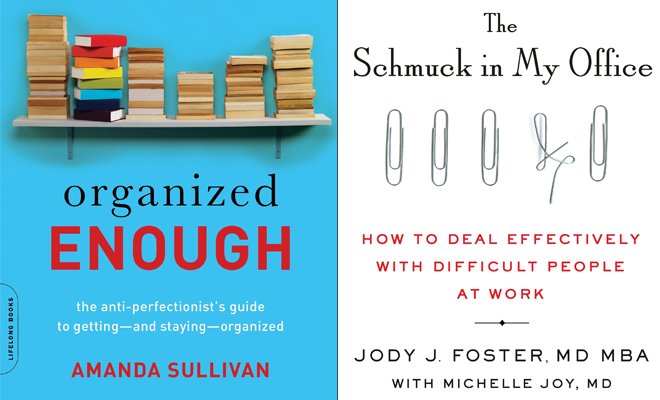
Organized Enough by Amanda Sullivan & The Schmuck in My Office by Jody J. Foster, MD MBA, with Michelle Joy, MD
You know exactly where Monday’s report is. You put that report in a safe place in your office, which is organized to work for you. But is it really organized, or is it just a mess?
Admit it; it’s probably the latter and nobody’s perfect, but with Organized Enough by Amanda Sullivan, you might find a perfect solution. You promised yourself on January 1 that you’d keep your office clean and your desk clear. First of the year, you were going to become a neatnik.
But of course, that’s “not sustainable,” says Sullivan. You set yourself up for perfection (and therefore, failure), when you should strive instead for “organized enough.” The first step, she says, is to “Go with the FLOW.” Forgive yourself for the things you impulsively bought or wasted money on. Understand that you can “Let stuff go,” starting with one small corner and ten minutes’ time. Throw things into the trash, donate other items, pay attention to unnecessary duplicates within a given category, and keep working; it might actually feel good! Then Organize what’s left and set up a time to keep Weeding on a regular basis.
Once you’ve let go of your fears (Will I have enough? Will I run out? Will it go up in price?) and your paper pile, it’s time to set good habits, starting with inventory. What’s in your supply room? You’ll never overbuy, if you know. Make time to organize, even if it’s just a minute; and always make “a last sweep” before lights-out, so you don’t start the day with a mess. Limit new purchases, “buy less but better,” and remember that nobody’s ever perfect. “What we want,” says Sullivan, “is joy…and to know where we put the car keys, and those things, my friends, are within your grasp.”
If you’ve been down this road before, what makes this book different from several thousand others on the subject? Amanda Sullivan isn’t proposing that you keep everything 100 percent shipshape. She only aims to help the ship stay afloat with fewer items in the cargo hold and an unobstructed captain’s chair. That means no guilt, no pressure, use the advice that’s applicable, discard what’s not, no problems. And if that’s what it takes, then Organized Enough might just work for you.
As you take a new look at organizing work flow, consider some thoughts to reorganize the way you deal with the difficult people with whom you work. The Schmuck in My Office by Jody J. Foster, MD MBA, with Michelle Joy, MD, has some guidance.
When she was in business school, Foster, a psychiatrist, was often amused and pleased to be a go-to person when conflicts arose. Classmates constantly asked for help in dealing with others who rankled them, and she was usually successful in smoothing ruffled feathers and feelings. What are her secrets?
First of all, she says, don’t assume that people are being jerks on purpose. Most folks act one way or other when they think they’re doing the right thing, or because they haven’t been told any differently. Oftentimes, they don’t know they’re bugging someone with their behavior, so Foster advocates compassion when dealing with conflicts. Consider the other person’s story and way of thinking. It helps to step into their shoes.
Then, and though Foster very strongly stresses that this book is not a psychiatry manual and that you shouldn’t make armchair diagnoses, understand that there are several basic kinds of office schmucks you might encounter in your work life. Narcissists thrive on compliments and hate being ignored. The Venus Flytrap loves chaotic and unstable relationships (think: Fatal Attraction). The Swindler only cares about the deal, and only if it benefits himself. The Bean Counter is obsessive and has difficulty letting things go, while Distracted people let go too easily. Then there are those with serious substance abuse problems, undiagnosed illnesses, true cultural differences or just plain eccentricities. Finally, says Foster, when you’re angry and digging for any possible reason to lend a shred of compassion, don’t forget to look inside. “Go get the mirror,” she says. “Hurry.”
Then go back and read the chapter titled Important Disclaimers, which you can’t keep in mind enough. Using real psychiatric diagnoses to battle an office pest can be fraught with danger, and Foster and Joy are careful to repeatedly warn readers of this. Yes, the possibilities are undeniably interesting, and it’s the rare person who hasn’t smugly rattled off a layman’s diagnosis for an office bother, but remembering that “There is an important distinction between personality traits…and personality disorders” is the key to using this book. It helps that the authors also offer end-of-chapter hints for both workers and bosses, too. This is fascinating; it may even teach you some compassion, so it’s recommended for anyone who works with others, shares an office, or supervises others. ■







